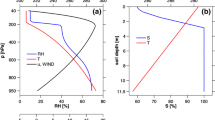Abstract
The atmospheric conditions during an observed case of open cellular convection over the North Sea were simulated using the Weather Research and Forecasting (WRF) numerical model. Wind, temperature and water vapour mixing ratio profiles from the WRF simulation were used to initialize an idealized version of the model, which excluded the effects of topography, surface inhomogeneities and large-scale weather forcing. Cells with an average diameter of 17.4 km developed. Simulations both with and without a capping inversion were made, and the cell-scale kinetic energy budget was calculated for each case. By considering all sources of explicit diffusion in the model, the budgets were balanced. In comparison with previous work based on observational studies, the use of three-dimensional, gridded model data afforded the possibility of calculating all terms in the budgets, which showed that the important terms in the budgets were buoyancy, pressure balance and inter-scale transfer to subgrid scales. Cells were also composited to calculate the average cell-scale flow and each of the budget terms on two-dimensional cross-sections through the cells, parallel and perpendicular to the mean wind direction.
Similar content being viewed by others
References
Agee EM (1987) Meso-scale cellular convection over the oceans. Dyn Atmos Oceans 10: 317–341
Agee EM, Chen TS (1973) A model for investigating eddy viscosity effects on mesoscale cellular convection. J Atmos Sci 30: 180–189
Atkinson BW, Zhang JW (1996) Mesoscale shallow convection in the atmosphere. Rev Geophys 34: 403–431
Bakan S, Schwarz E (1992) Cellular convection over the North-Eastern Atlantic. Int J Climatol 12: 353–367
Bennett LJ, Weckwerth TM, Blyth AM, Geerts B, Miao Q, Richardson YP (2010) Observations of the evolution of the nocturnal and convective boundary layers and the structure of open-celled convection on 14 June 2002. Mon Weather Rev 138: 2589–2607. doi:10.1175/2010MWR3200.1
Brümmer B (1985) Structure, dynamics and energetics of boundary layer rolls from KonTur aircraft observations. Contrib Atmos Phys 58: 237–254
Brümmer B, Pohlmann S (2000) Wintertime roll and cell convection over Greenland and Barents Sea regions: a climatology. J Geophys Res 105: 15559–15566
Brümmer B, Fisher T, Zank S (1986) Aircraft observations of open cellular structures during KonTur. Contrib Atmos Phys 59: 162–184
Cieszelski R (1998) A case study of Rayleigh-B énard convection with clouds. Boundary-Layer Meteorol 88: 211–237
de Roode SR, Duynkerke PG, Jonker HJJ (2004) Large-eddy simulation—how large is large enough. J Atmos Sci 61: 403–420
Helfand M, Kalnay E (1983) A model to determine open or closed cellular convection. J Atmos Sci 40: 631–650
Hong SY, Noh Y, Dudhia J (2006) A new vertical diffusion package with an explicit treatment of entrainment processes. Mon Weather Rev 134: 2318–2341
Hundsdorfer W, Koren B, van Loon M, Verwer JG (1995) A positive finite-difference advection scheme. J Comput Phys 117: 35–46
Kain JS, Fritsch JM (1990) A one-dimensional entraining/detraining plume model and its application in convective parameterization. J Atmos Sci 47: 2784–2802
Knievel JC, Bryan GH, Hacker JP (2007) Explicit numerical diffusion in the WRF model. Mon Weather Rev 135: 3808–3824
LeMone MA (1973) The structure and dynamics of horizontal roll vortices in the planetary boundary layer. J Atmos Sci 30: 1077–1091
LeMone MA (1976) Modulation of turbulence energy by longitudinal rolls in an unstable planetary boundary layer. J Atmos Sci 33: 1308–1320
Miura Y (1986) Aspect ratios of longitudinal rolls and convection cells observed during cold air outbreaks. J Atmos Sci 43: 26–39
Müller G, Chlond A (1996) Three-dimensional numerical study of cell broadening during cold-air outbreaks. Boundary-Layer Meteorol 81: 289–323
Ross B, Agee E (1985) Aircraft investigation of wintertime convective and non-convective boundary layers over the East China Sea. J Meteorol Soc Jpn 63: 405–416
Schröter M, Raasch S, Jansen H (2005) Cell broadening revisited: results from high-resolution large-eddy simulation of cold air outbreaks. J Atmos Sci 62: 2023–2032
Sikora TD, Young GS, Fisher CM, Stepp M (2011) A synthetic aperture radar-based climatology of open cell convection over the northeast Pacific Ocean. J Appl Meteorol Climatol 50: 597–603. doi:10.1175/2010JAMC2624.1
Skamarock WC (2004) Evaluating mesoscale NWP models using kinetic energy spectra. Mon Weather Rev 132: 3019–3032
Skamarock WC, Klemp JB (2008) A time-split hydrostatic atmospheric model for weather research and forecasting applications. J Comput Phys 227: 3465–3485
Skamarock WC, Klemp JB, Dudhia J, Gill DO, Barker DM, Duda MG, Huang XY, Wang W, Powers JG (2008) A description of the advanced research WRF version 3. NCAR technical note TN-475+STR. NCAR, Boulder
Smagorinsky J (1963) General circulation experiments with the primitive equations. Mon Weather Rev 91: 99–164
Stull RB (1988) An introduction to boundary layer meteorology. Kluwer Academic Publishers, Dordrecht
Thompson G, Rasmussen RM, Manning K (2004) Explicit forecasts of winter precipitation using an improved bulk microphysics scheme. Part I: Description and sensitivity analysis. Mon Weather Rev 132: 519–542
Wang H, Feingold G (2009a) Modelling cellular structures and drizzle in marine stratocumulus. Part I: Impact of drizzle on the formation and evolution of open cells. J Atmos Sci 66: 3237–3256
Wang H, Feingold G (2009b) Modelling cellular structures and drizzle in marine stratocumulus. Part II: The microphysics and dynamics of the boundary region between open and closed cells. J Atmos Sci 66: 3257–3275
Wicker LJ, Skamarock WC (2002) Time-splitting methods for elastic models using forward time series. Mon Weather Rev 130: 2088–2097
Wyngaard JC (2004) Toward numerical modelling in the “terra incognita”. J Atmos Sci 61: 1816–1826
Author information
Authors and Affiliations
Corresponding author
Rights and permissions
About this article
Cite this article
Vincent, C.L., Hahmann, A.N. & Kelly, M.C. Idealized Mesoscale Model Simulations of Open Cellular Convection Over the Sea. Boundary-Layer Meteorol 142, 103–121 (2012). https://doi.org/10.1007/s10546-011-9664-7
Received:
Accepted:
Published:
Issue Date:
DOI: https://doi.org/10.1007/s10546-011-9664-7




